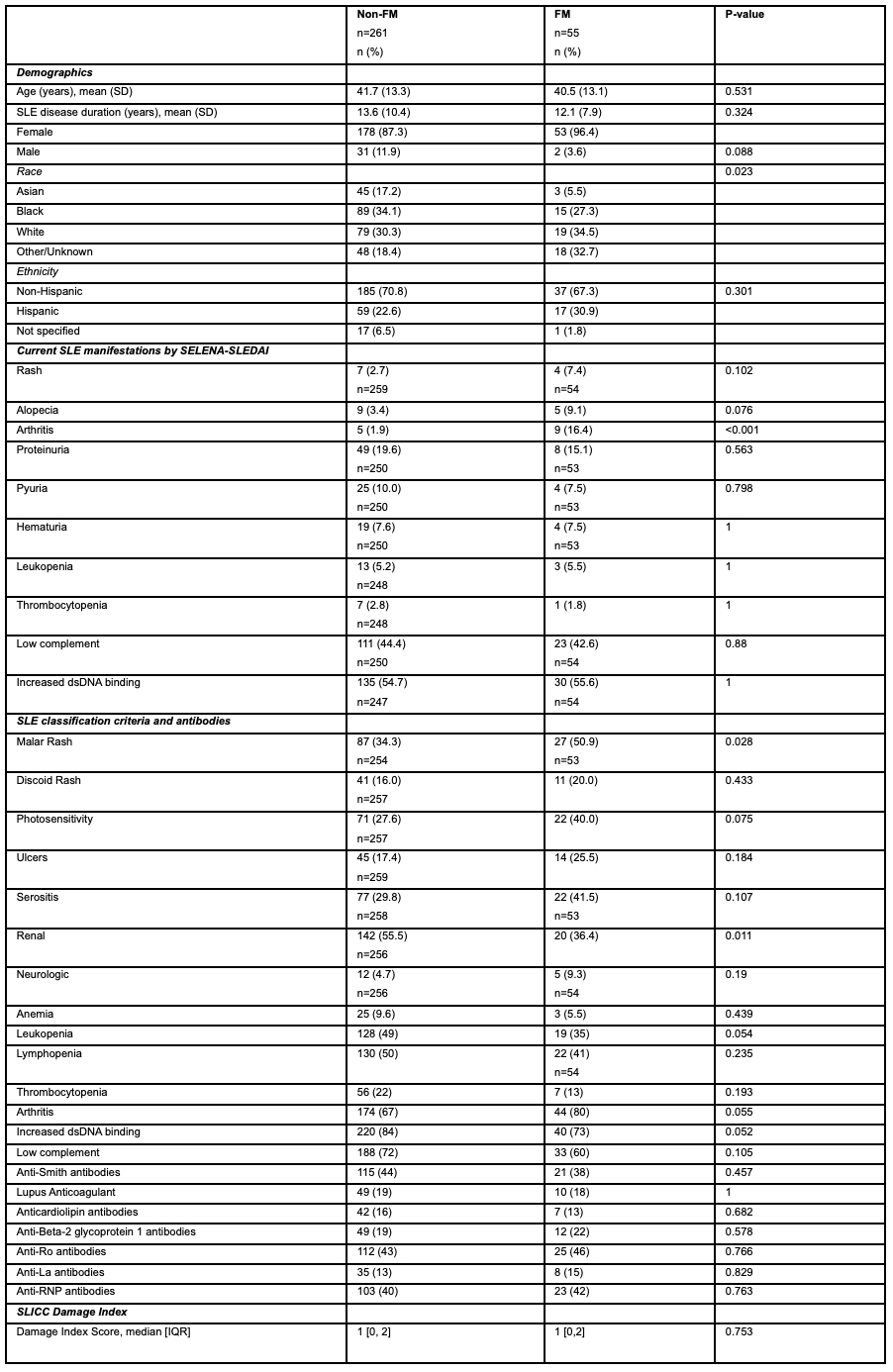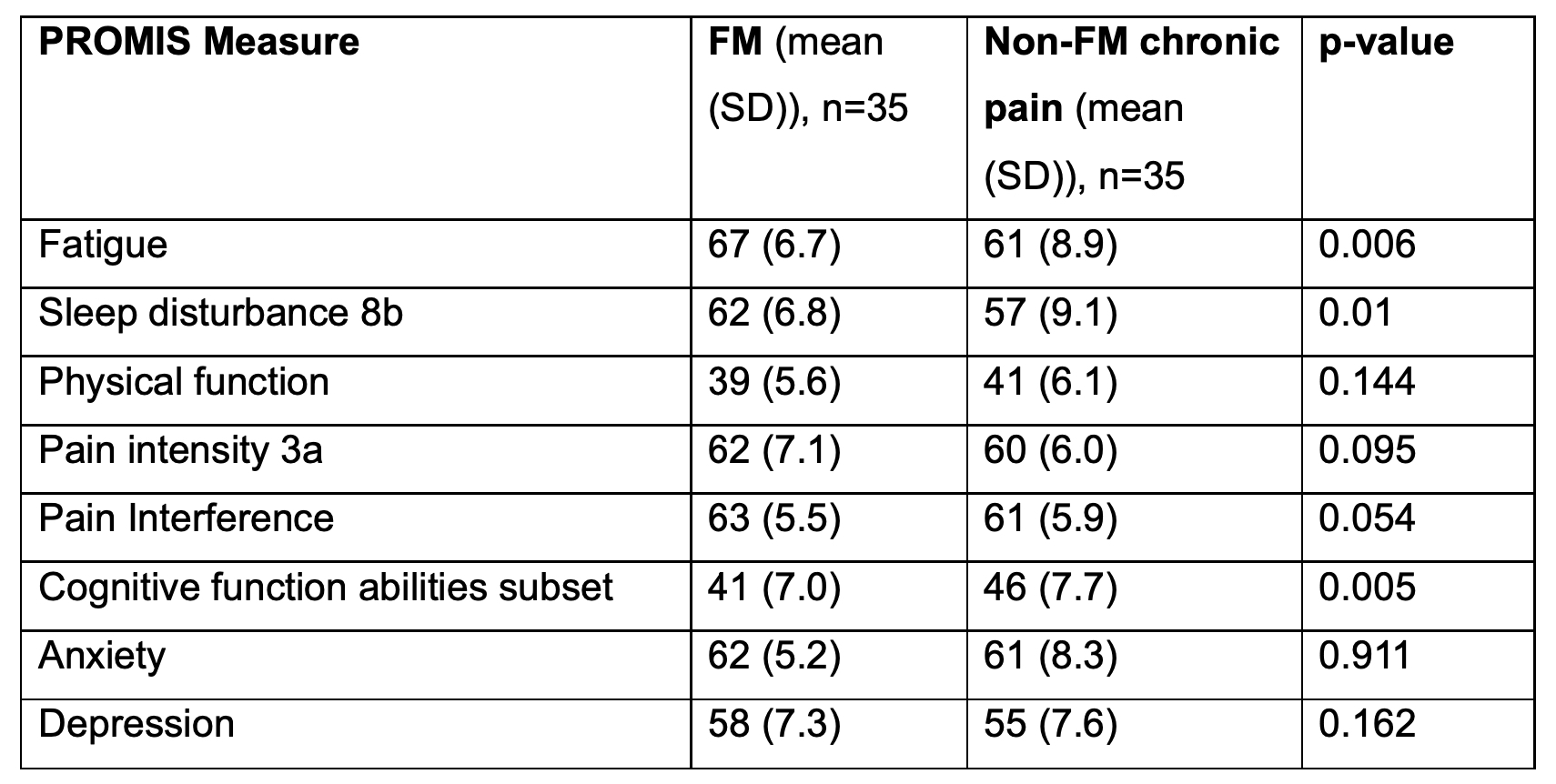Session Information
Date: Tuesday, November 14, 2023
Title: (1827–1839) Fibromyalgia & Other Clinical Pain Syndromes Poster
Session Type: Poster Session C
Session Time: 9:00AM-11:00AM
Background/Purpose: SLE patients have a higher prevalence of fibromyalgia (FM) than the general population. FM symptoms, such as nociplastic pain and fatigue, are known to cause discordance in how patients and physicians view well-controlled SLE, and these variables impact quality of life in ways not captured by traditional disease activity scores. There is a paucity of objective data surrounding the clinical interplay of these two diseases. Given this, and emerging evidence suggesting the contribution of autoimmunity to FM, this study evaluated FM clinically, serologically, and via patient reported outcomes in a multi-racial/ethnic SLE patient cohort.
Methods: Patients from an established lupus cohort were screened for FM using the 2016 FM classification criteria during an in-person rheumatologist visit. Hybrid SELENA-SLEDAI scores, SLE classification criteria, medications, and SLICC damage index were evaluated. A portion of the patients who reported any chronic pain also completed 8 PROMIS measures. Clinical and serologic activity was compared in patients with and without FM, as well as T-score means of PROMIS measures between FM and non-FM chronic pain patients. For T-score means significantly different between groups, linear regression models adjusting for age, race/ethnicity, SELENA-SLEDAI score, and steroid use were estimated.
Results: Of 316 SLE patients completing the FM questionnaire, 55 (17%) met criteria for FM, 57 (18%) reported chronic pain without FM, and 204 (65%) had no chronic pain. The racial/ethnic composition of the FM patients was 35% White, 27% Black, 6% Asian, and 31% Hispanic, which differed from those without FM (p=0.023), primarily due to a smaller proportion of Asian patients with FM. There was no significant difference in overall SELENA-SLEDAI score. However, there was more active arthritis in the FM group versus the non-FM group (Table 1). The widespread pain index (WPI) and symptom severity score (SSS) were not correlated with current degree of SLE activity in FM or in non-FM chronic pain patients (Figure 1). Of the SLE criteria, FM patients were less likely to have ever had lupus nephritis and more likely to have malar rash. The SLICC damage index did not differ between groups. Of the 112 patients with chronic pain (plus/minus FM), 70 completed at least one PROMIS measure. Fatigue, sleep disturbance, and cognitive function were significantly worse in FM patients, whereas pain measures, depression, anxiety, and physical function did not differ between groups (Table 2). After adjusting for age, race (White/non-Hispanic), SELENA-SLEDAI score, and current steroid use, FM was associated with a 5-point increase in mean sleep disturbance and fatigue scores. Cognitive function, however, was no longer significantly associated with FM.
Conclusion: These findings underscore that symptoms associated with FM in SLE patients can be independent of chronic pain, SLE disease activity and damage, and overall suggests the need for better understanding of the biology of this group.
To cite this abstract in AMA style:
Corbitt K, Carlucci P, Cohen B, Masson M, Belmont H, Saxena A, Tseng C, Wang J, Barbour K, Buyon J, Izmirly P, Gold H. Evaluation of Fibromyalgia, Clinical/Serologic Activity, and Patient Reported Outcomes in a Racially/Ethnically Diverse SLE Patient Cohort [abstract]. Arthritis Rheumatol. 2023; 75 (suppl 9). https://acrabstracts.org/abstract/evaluation-of-fibromyalgia-clinical-serologic-activity-and-patient-reported-outcomes-in-a-racially-ethnically-diverse-sle-patient-cohort/. Accessed .« Back to ACR Convergence 2023
ACR Meeting Abstracts - https://acrabstracts.org/abstract/evaluation-of-fibromyalgia-clinical-serologic-activity-and-patient-reported-outcomes-in-a-racially-ethnically-diverse-sle-patient-cohort/



